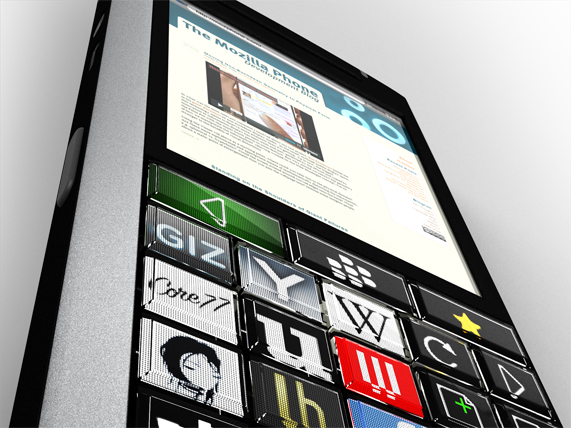 After a brief flirtation with the Blackberry Storm, I’ve recently become an iPhone user — and so far, I’ve been very happy with it. But off hand I can think of at least 30 things I wish the iPhone did, could do better, or wish I could change. Unfortunately for me (or perhaps fortunately, depending on your design philosophy), Apple is a very opinionated company. They don’t really care what I think — I have to either do things their way, or buy from someone else.
After a brief flirtation with the Blackberry Storm, I’ve recently become an iPhone user — and so far, I’ve been very happy with it. But off hand I can think of at least 30 things I wish the iPhone did, could do better, or wish I could change. Unfortunately for me (or perhaps fortunately, depending on your design philosophy), Apple is a very opinionated company. They don’t really care what I think — I have to either do things their way, or buy from someone else.
But what if there was a mobile phone that encouraged user feedback from the start? Would the end result be better? Even Google’s open source mobile operating system Android was kept under wraps until it was nearly ready to ship, and the design on the hardware end of the HTC phone that first ran it was a traditionally closed process. Today, however, I read a blog post by Dwight Silverman at the Houston Chronicle about the Mozilla Phone (a.k.a. the Open Web Phone).
The Mozilla Phone is part of Mozilla Labs’ design concept series and is being led by designer Billy May. The idea is to foster a discussion with users, developers, and designers about how to create a phone that “might interface more seamlessly with users.” All are invited to participate by submitting concepts, ideas, and commenting on the design blog.
A Mozilla Phone, says May, will be all about user choice. After all, the typical Mozilla user starts with the standard IE+Outlook experience, but he or she then chooses Firefox+Thunderbird (or Gmail, or Yahoo!, or whatever).
“Without delving into actual implementation, it is obvious the hardware interface of the phone needs to empower the user through choice,” writes May. “By giving the user the means to define how he or she interacts with media, contacts and the web, the relationship between the user and their phone fundamentally changes (in a good way).”

Whether the Mozilla Phone concept series actually yields anything that goes into production or not, the idea of community powered design is neat. Design by consensus doesn’t generally work — there needs to be a guiding force in the form of a core team or single person that can make ultimate decisions when necessary to prevent wild tangents, groupthink, or break deadlocks. But an open design process could yield some very cool results — who better to know what sort of things they’d want their phone do than the people who use them every day, after all?
May this week posted the first throwaway concept of the Mozilla Phone. He admits it is nothing stellar — really just a Blackberry mashed up with Art Lebedev’s OLED keyboard. Nonetheless, the point is to get a conversation going. “So where does this idea go? How can every square millimeter of a phone both input and output information to the user? How can our buttons, screens, speakers and trackballs communicate to more of our senses?” asks May.
So far, he’s received a few thought provoking replies, but for the Mozilla Phone to be a success, for it to lead to any sort of worthwhile outcome (like concepts that find their way into production somewhere), the community will need to get more involved. I’m looking forward to seeing what else comes out of May’s Mozilla Phone project.
Frequently Asked Questions about Mozilla Phone and Dream Phone
What is the Mozilla Phone project all about?
The Mozilla Phone project is an initiative by Mozilla, the organization behind the popular Firefox browser, to create an open-source smartphone. The project aims to give users the ability to customize their phones to their liking, from the hardware to the software. This is a stark contrast to the current smartphone market, where users have to adapt to the phone’s design and features.
How does the Mozilla Phone project differ from other smartphones in the market?
Unlike other smartphones in the market, the Mozilla Phone project is open-source. This means that anyone can contribute to its development, whether it’s by designing new hardware components or creating new software features. This collaborative approach allows for a greater level of customization and innovation.
Can I contribute to the Mozilla Phone project?
Yes, you can contribute to the Mozilla Phone project. Since it’s an open-source project, anyone can contribute to its development. You can design new hardware components, create new software features, or even help with testing and bug fixing.
What is the Dream Phone board game?
The Dream Phone board game is a popular game from the 90s where players have to guess who has a crush on them by calling different boys on the game’s electronic phone. The game is known for its nostalgic appeal and fun gameplay.
Where can I buy the Dream Phone board game?
The Dream Phone board game can be purchased from various online retailers such as eBay and Amazon. It’s also sometimes available in thrift stores and garage sales.
Is the Dream Phone board game suitable for children?
Yes, the Dream Phone board game is suitable for children. However, due to its dating theme, it’s recommended for children aged 9 and up.
What is the connection between the Mozilla Phone project and the Dream Phone board game?
There is no direct connection between the Mozilla Phone project and the Dream Phone board game. The two are mentioned together in this article to illustrate the concept of customization and personalization in technology.
Can I play the Dream Phone board game on the Mozilla Phone?
Currently, there is no app or software that allows you to play the Dream Phone board game on the Mozilla Phone. However, since the Mozilla Phone project is open-source, it’s possible that someone could develop such an app in the future.
How can I stay updated on the progress of the Mozilla Phone project?
You can stay updated on the progress of the Mozilla Phone project by following Mozilla’s official website and social media channels. They regularly post updates and news about their various projects.
Are there any other open-source smartphone projects I should know about?
Yes, there are several other open-source smartphone projects out there. Some notable ones include the PinePhone by Pine64 and the Librem 5 by Purism. These projects, like the Mozilla Phone project, aim to give users more control over their smartphones.
